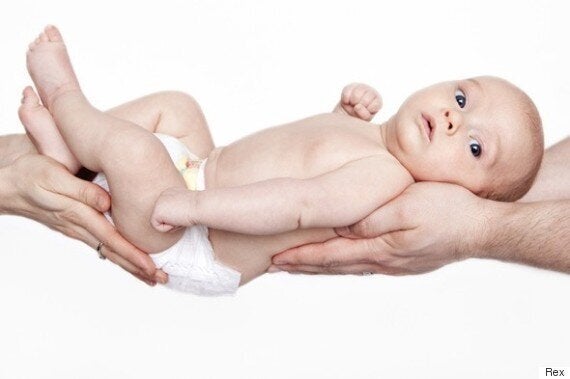Your two to three-month-old baby is learning fast, and you'll be amazed at how accomplished he can become in quite a short time. During this period of time he will reward you with lovely smiles – real ones, not just windy grimaces!

It's a joy to see happiness on your baby's face and is very affirming of your own parenting skills, too.
The following milestones usually occur during this nine-12 week period – but don't be alarmed if your baby isn't 'keeping up' with all of these.
Have a word with your health visitor or GP in case there is a reason for developmental delay, but the chances are your baby is just going at his or her own pace.
Mobility And Motor Skills
• You may notice your baby lifting her head and holding it up when she's on her tummy. She won't be able to hold this position for long (who'd want to?) but it'll show that she's interested in her surroundings and that her neck muscles are becoming stronger.
• Your baby may even bring her chest and shoulders off the floor when she's on her tummy! This is a sign that her back and spine are gaining in strength, too.
• Those little arms and legs will be getting plenty of muscle-strengthening exercise as your baby kicks out and waves about.
• If you touch your baby's palm with your fingertip, you'll probably find she grasps your finger firmly in return.
Sociability And Senses
• Your baby will enjoy the sound of your voice and will seem to listen intently. Try singing or talking in a sing-song voice to keep her amused.
• Smiles will be frequent and lovely.
• Your baby will start cooing, babbling and chuckling – another magical sound. This is her language, so respond whenever you hear her, then wait and see if she replies!
• As visual muscle strength and coordination increases your baby will be able to follow moving objects with her eyes: the best distance to dangle and move toys around in front of her is around 20cm/8in from her face.
• Keep up the face-pulling games, as your baby will enjoy copying you.
Check with your health visitor or GP if:
• Your baby makes no attempts to follow a nearby moving object with her eyes or continues to squint after 12 weeks.
• Doesn't smile.
• Doesn't hold her head up, even for short periods.
• Doesn't grasp a finger when her palm is stroked.

THROUGH YOUR BABY'S EYES
From around his ninth week your baby will have developed the ability to 'fix' on objects and faces with his eyes. This means he'll be able to gaze with some concentration for short periods. Faces are his favourite thing to look at, and he'll be fascinated if you pull different faces.
Try making an 'O' with your mouth (you may have been doing this from the time he was a newborn) and watch as he tries to copy you. You can make a game of this exchange of expressions.
Now is the time your baby may enjoy a cot mobile, as he enjoys watching moving objects as well. His concentration span is still short, so do feel disheartened if he only appears to watch it for a few seconds or so before losing interest. The little time he does spend will awaken his curiosity and stimulate his imagination.
Before long his hand-eye coordination will have developed to the extent that he'll reach out to grab things ou dangle in front of him. In fact, you'll notice that his interest in his own hands becomes quite marked around this time.
From around now, your baby may notice and take an interest in things about two metres away rather than just close up - although he'll still look for longer and more closely at near objects.
He'll almost certainly recognise your face and feel reassured by it. You'll know this when he smiles or giggles when you walk into the room.
Up until now, you may have noticed your baby's eyes 'drifting' - focusing in different directions or barely seeming to focus for any length of time. By week 12, you should see your baby's eyes focusing more strongly and together, so that any appearance of a squint is gone.
If your baby still seems to be squinting - either in one eye, both eyes or alternating eyes, it's important you get a professional medical opinion, as early diagnosis is very important in correcting a squint effectively.
GAMES TO PLAY WITH YOUR BABY
Your baby's interest in the world around him is growing all the time, and he'll particularly enjoy sensory games, so try to think inventively when you're playing with him.
Give him things to grasp: a rattle; a small soft toy; your finger; a plastic spoon. Avoid things that could hurt him if he bangs them against himself. Make sure you encourage your baby to use both his hands: it'll help with coordination as well as muscle strength.
As his neck grows stronger and he's able to hold his head up for short bursts, take your baby by the hands and gently pull him to sitting up, then lower him slowly. He'll love the see-saw effect and it'll help strengthen his back.
Stimulate your baby's hearing by introducing him to a variety of different sounds: burst some bubble wrap near him; crinkle some greaseproof paper, then let him try; shake his rattle; activate a musical toy. Make the sounds to either side of his head so that he turns to find the source, and vary the order of sounds you make: he'll enjoy the element of surprise.
By the time he's three months old your baby might already be able to roll from his front on to his back, and you can encourage him by gently placing him on his tummy and physically turning him yourself. It will be months yet before he can roll from his back to his tummy. Make a game of turning him: perhaps sing a special song or play some music.
Your baby might well enjoy an activity arch or cot toy, as long as you place everything within swiping distance and never leave him to play unsupervised. Switch the order of the hanging toys from time to time and see if you think your baby has noticed - chances are he has!
By three months he'll probably be able to lean up on his forearms and look up when lying on his tummy, so encourage this by dangling toys near him so he can track them with his eyes.
Handing your baby a toy he can grasp easily, such as a teething ring, will help him practice hand skills in readiness for passing things from hand to hand. He'll be able to let go of things as well as grasp them now, so be prepared for picking up after him a lot from now on!
IMMUNISATIONS IN YOUR BABY'S FIRST YEAR
The childhood immunisation programme has all but wiped out some of the most serious diseases in the world, and every responsible parent should take it up for their child.
The idea of your baby having a jab or two isn't the happiest thought in the world, but when you consider that it could save her life and the lives of others, it puts things into perspective. The jabs are only momentary and usually cause little or no discomfort, so be reassured: your baby will, in all likelihood, be absolutely fine afterwards.
Here's a rundown to what happens when and what to expect.
At 2 months:
Your baby will be given a 5-in-1 single jab known as DTaP/IPV/Hib, which stands for diphtheria, tetanus, pertussis (whooping cough), polio and Haemophilus influenzae type b (Hib, a bacterial infection that can cause severe pneumonia or meningitis in young children). She'll also have a jab to protect against pneumococcal infection.
At 3 months:
The second dose of the 5-in-1 is given, along with a jab against meningitis C.
At 4 months:
The third dose of the 5-in-1 is given, as well as a second dose against pneumococcal infection and a second dose against meningitis C.
Between 12 and 13 months:
The third dose of meningitis C is given, together with a fourth dose against Hib. These are administered in one single jab, known as Hib/MenC. The MMR (measles, mumps and rubella) immunisation is also given as a single jab, along with a third dose against penumococcal infection, given as another separate jab.
9-12 WEEKS CHECKLIST
Some time during this period you should receive an appointment for your baby's second round of immunisations including a spearate meningitis C jab. If you haven't been sent a notification, do get in touch with your GP's surgery or baby clinic so you don't miss the boat.
It's very important to have all the injections, rather than imagining your baby is covered by the first lot: she's not. Missing out on immunisations means there's a danger of the serious childhood diseases returning, and you're not only putting your own baby at risk, but everyone else's too.
Start giving your baby more time on her tummy when she's awake and out of her cot. You must supervise this time, though, to prevent any possibility of her suffocating. It's important she spends time lying on her front to help her strengthen her neck muscles as she lifts her head.
How this helps:
It will help prevent her from getting a flat spot on the back of her skull. It will also encourage your baby to kick her legs, exercising her large motor muscles.
It's good practice, too, for when she's ready to push herself up and roll over.
If you haven't yet begun reading to your baby, it's not too soon to start.
How this helps:
She's ready to start getting an ear for language, and if you choose board books with different textures for her to feel, she'll be getting a whole sensory workout each time you share a book.
Babies love repetition. Reading the same book over and over, whilst varying the tone of your voice and using some expressions of surprise and delight, will convey a feeling of excitement to your baby.
You'll be engendering an early love of books in your baby.

SAFE CO-SLEEPING WITH YOUR BABY
A study carried out at Durham University found that around 70% of babies bed share with one or both parents in the first three months of life.
It's understandable if you want to bring your baby into bed for a night-time feed as long as you don't fall asleep, but the advice from the Department of Health and The Foundation for the Study of Infant Deaths (FSID) is to sleep your baby in their own cot in your bedroom for the first six months of life.
Other research has concluded that it is particularly dangerous to co-sleep with your baby in the first four months, and UNICEF also advises against the practice, saying, "Adult beds are not designed with infant safety in mind. Babies can die if they get trapped or wedged in the bed or if a parent lies on them. So the safest place for a baby to sleep is in a cot by your bed."
In addition, FSID strongly urges parents to take notice of the following guidelines on bedsharing:
It's especially dangerous for your baby to sleep in your bed if you (or your partner)
• are a smoker, even if you never smoke in bed or at home
• have been drinking alcohol
• take medication or drugs that make you drowsy
• feel very tired;
Or if your baby:
• was born before 37 weeks
• weighed less than 2.5kg or 5½ lbs at birth.

SLEEP TRAINING YOUR BABY
Sleep deprivation is the scourge of new parents, and anything you can try to encourage your baby to sleep will probably seem very appealing.
It's unrealistic to expect a baby under around six weeks to fall into any routine - athough it's not uncommon for very young newborns to sleep through the night at first, lulling their parents into a false sense of security!
From around six weeks, though, when both you and your baby will probably have found some sort of rhythm to your days, it's worth trying to establish some sort of regular routine.
Daytime Naps
Newborns do need to sleep during the day, so don't try to wake your baby when she drops off. Instead, follow the advice of other new mums and use the time to sleep yourself - this will help you cope with some of the effects of disrupted nights.
What can help is to aim to be in the car or at home when your baby usually naps, so that the time becomes predictable, and to teach your baby the difference between daytime and night-time sleep, so that she expects to sleep for longer at night.
You can do this by putting her down for her daytime naps in a daylit room (but out of direct sunlight), and by continuing your own routine around her - in other words, not tiptoeing around for fear of waking her.
When you put her down in her cot for the night, make sure the conditions are quite different: make the room dark.
The Importance Of Routine
Babies from around six weeks thrive on routine: they feel secure if the same things happen at the same times of day. About an hour before you want to put your baby down for the night, start winding down and creating a more sleepy environment.
If you find a bath makes her sleepy, save this for the evening; otherwise, do a gentle top and tail clean-up. If she loves baby massage, do this straight after her bath or top and tail.
Dress her in a clean nappy and a fresh vest and stretchsuit, to get her used to the idea that we have different clothes for daytime and sleep time. Read or sing to her gently, and follow this with a final feed. Then try to put her down in her cot when she's drowsy rather than fully asleep, as this will encourage her to settle herself. Plus, if she wakes in the night, she's less likely to need you there to rock her back to sleep.
Sleep Techniques You Can Try
Crying down
With this method, you allow your baby to cry herself off to sleep, as long as you know that she's clean, comfortable and well fed. It's particularly effective if she's whimpering rather than crying from the lungs, as it's sometimes a symptom of over-tiredness and will often be followed by full submission to sleep!
Having said that, it's hard to resist the urge to comfort a crying baby. The key here is to wait five minutes or so before going back, then to keep the comforting minimal: try patting her gently on the chest or speaking to her softly for a minute or two, but no more, then leave the room again.
If she still doesn't settle, go back after a further 5-10 minutes and do the same. Repeat until your baby's asleep and keep to this routine every night.
Checking
This is most suited to babies from six months, and involves letting your baby cry for five minutes or so, then returning just to check on her. You don't offer cuddles, feeds or stories - just say 'goodnight' in a firm but calm voice and leave.
Then you repeat this, gradually extending the length of time you're out of the room, until your baby learns that there's no great reward for making a fuss and gives in to sleep.
Gradual retreat
With this method, you don't offer physical comfort either, but just sit on a chair next to the cot until your baby's asleep.
Each night you gradually move your chair a little further away until she'll settle if you're just outside the door. This method works best on older babies from around 7-9 months, who've worked out that they are entirely separate from you, so may feel anxious at being left.
It usually takes between one and two weeks to work consistently, so you'll need to persevere.
If all else fails
Don't beat yourself up if you just can't stick to any of these methods or make them work. You can maybe find your own technique. The main advice is to avoid cossetting a wakeful baby as she'll learn that you'll come running with cuddles, kisses and any other manner or comforts as long as she keeps on crying.
The aim is to break the association with crying and comfort once she's reached the six-week or so mark, but if all else fails, do reassure yourself that she'll find a rhythm for sleeping eventually and it's only a phase.
SWITCHING FROM BREAST TO BOTTLE

There's no argument against the fact that breast milk is best for babies, but the truth is that, for a variety of reasons, many new mums do choose to switch to bottles. For some women, it's because of problems with positioning or milk supply; for others, it's to gain more flexibility in terms of allowing partners and others carers to feed their babies. Some mums - especially if they're going back to work - choose to express their milk, which means having to introduce bottle feeding.
If you're not keen to continue with breastfeeding because it's too painful or difficult, your midwife or health visitor should be able to offer you extra help to continue - and there are breastfeeding counsellors who provide excellent support, too.
But if you've come to the final decision to use bottles or a combination of breast and bottle to feed your baby, we've put together a guide to making the transition successfully. It's best to start a bit ahead of the time you think you'll need to make the switch, in case you don't meet with success at first.
You will need...
To make the switch, you'll first need to have bought four feeding bottles and teats; a steriliser (steam or microwave are generally easiest), and a bottle brush. There are lots of different shaped bottles and teats to choose from.
Some mums prefer the squat, fat bottles; others go for the longer, slimmer ones. The best advice is to choose whatever shape is compatible with the steriliser you've bought.
Some manufacturers claim their bottles reduce colic by inhibiting the amount of air that can fill the space between milk and teat. Why not read online reviews before you buy.
There is such an array of teats on offer that it'll probably be a case of trial and error to find what suits your baby best. Some are orthodontic; some are anti-colic; some are silicone and others are rubber. You'll find fast, medium and slow flow teats with different sized holes.
Just don't buy too many of the same type to begin with in case you need to make a switch.
First introductions
• Trying to give your baby milk from a bottle when she's really hungry and not expecting it could prove to be pretty traumatic, so it's a good idea to start offering your baby drinks of water or milk when she's already had the edge taken off her hunger.
You could start, for instance, by expressing milk from one of your breasts, then offering her the other breast to start a feed. Then try giving her the expressed milk in a bottle once she's had part of a feed. Or offer a little cooled, boiled water in between feeds.
If she's reluctant, try some of these tips:
• If your baby won't accept a bottle from you, try asking someone else to offer it to her: it might be that because she can smell your breast milk, she won't settle for anything less - a problem that won't arise if your partner tries.
• If your baby's old enough to hold things, let her have the bottle to play with before you offer it filled.
• If she seems willing to take the bottle, but doesn't seem to like the contents, it might be worth letting the milk cool to room temperature: after all, that's the temperature breastmilk is served at! Some babies even prefer bottle milk cold from the fridge.
• Experiment with different feeding positions: maybe try a feeding chair, where you baby lies back and faces you; or try sitting her more upright than she's used to at the breast.
• If you don't have any success getting your baby to accept a bottle, don't be too disheartened: put it off for a while and start again in a week or so's time.
Trying to force the issue will only be stressful for you and your baby.
THINGS TO DO FOR YOURSELF
By now you're probably starting to feel you've got some sort of routine with your baby cracked. Chances are you'll be able to gauge when she's likely to get sleepy, hungry or bored. You might even have some success with predicting when she's likely to fill her nappy.
All of this means you should be feeling a bit more confident about getting out and about with your baby.
So why not:
• Start a coffee morning rota, where you and your postnatal group take it in turns to meet at each other's houses for a couple of hours on a regular basis.
• Go further afield than you have previously, taking the opportunity to visit friends or relatives you don't see very often.
• Sort out a babysitter - someone your baby knows well, like your parents or in-laws - and have an afternoon or evening out with your partner. It'll be even better if you surprise him with the arrangement!
• Treat yourself to a new outfit. You may not have lost your baby weight, but there are very affordable clothes in supermarkets that won't cost the earth and you can always sell clothes on later. It will give you a confidence boost wearing something new that isn't maternity size!
• Get together with old colleagues: take your baby in to work to meet them if you haven't done so already. The likelihood is that within minutes there'll be bartering over who will cuddle your baby next, and as long as your baby is happy to be passed around, you'll be free to chat with the grown-ups!
• Go out for a girls' night out, leaving your other half in charge for the evening. He may feel as nervous as you about the prospect, but the time has to come sooner or later, and he'll find he can cope fine.
• If you're breastfeeding, think about expressing your milk to give you more freedom.